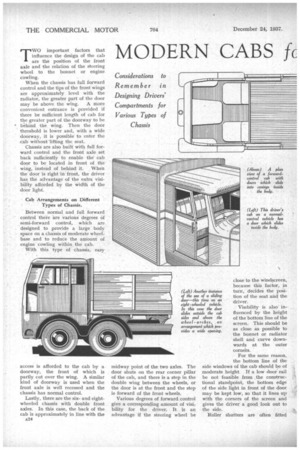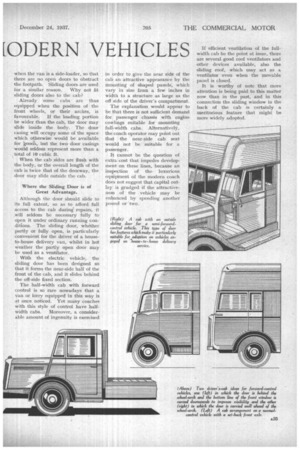MODERN CABS fc CODERN VEHICLES
Page 12

Page 13

If you've noticed an error in this article please click here to report it so we can fix it.
TWO important factors that influence the design of the cab are the position of the front axle and the relation of the steering wheel to the bonnet or engine cowling.
When the chassis has full forward control and the tips of the front wings are approximately level with the radiator, the greater part of the door may be above the wing. A more convenient entrance is provided if there be sufficient length of cab for the greater part of the doorway to be ' behind the wing. Then the door threshold is lower and, with a wide doorway, it is possible to enter the cab without 'lifting the seat.
Chassis are also built with full forward control and the front axle set back sufficiently to enable the cab door to be located in front of. the wing, instead of behind it. When the door is right-in front, the driver has the advantage of the extra visibility afforded by the 'width of the door light.
Cab Arrangements on Different Types of Chassis.
Between normal and full forward
• control there 'are various degrees of .semi-forward control, which are designed to provide a large body space on a chassis of moderate wheelbase and to reduce the amount of engine cowling within the cab.
With this type of chassis, easy access is afforded to the cab by a doorway, the front of which is partly cut over the wing. A similar kind of doorway is used when the front axle is well recessed and the chassis has normal control.
Lastly, there are the sixand eightwheeled chassis with double front axles. In this case, the back of the cab is approximately in line with the A24 midway point of the two axles. The door shuts on the rear corner pillar of the cab, and there is a step in the double wing between the wheels, or the door is at the front and the step is forward of the front wheels.
Various degrees of forward control give a corresponding amount of visi; bility for the driver. It is an advantage if the steering wheel be
close to the windscreen, because this factor, in turn, decides the position of the seat and the driver.
Visibility is also influenced by the height of the bottom line of the screen. This should be as close as possible to the bonnet or radiator shell and curve downwards at the outer corners.
For the same reason, the bottom line of the side windows of the cab should be of moderate height. If a low door rail be not feasible from the constructional standpoint, the bottom edge of the side light in front of the door may be kept low, so that it lines up. with the corners of the screen and gives the driver a good look out to the side. 4. Roller shutters are often fitted
when the van is a side-loader, so that there are no open doors to obstruct the footpath. Sliding doors are used for a similar reason. Why not fit sliding doors also to the cab?
Already some cabs are thus equipped when the position of the front wheels, or their arches, is favourable. If the loading portion be wider than the cab, the door may slide inside the body. The door casing will occupy some of the space which otherwise would be available for koods, but the two door casings would seldom represent more than a total of 10 cubic ft.
When the cab sides are flush with the body, or the overall length of the "cab is twice that of the doorway, the door may slide outside the cab.
Where the Sliding Door is of Great Advantage.
Although the door should slide to its full extent, so as to afford full access to the cab during repairs, it will seldom be necessary fully to open it under ordinary running conditions. The sliding door, whether partly or fully open, is particularly convenient for the driver of a houseto-house delivery van, whilst in hot Weather the partly open door may be used as a ventilator.
With the electric vehicle, the sliding door has been designed so that it forms the near-side half of the front of the cab, and it slides behind the off-side fixed section.
The half-width cab with forward control is so rare nowadays that a van or lorry equipped in this way is at once noticed. Yet many coaches with this style of control have halfwidth cabs. Moreover, a considerable amount of ingenuity is exercised in order to give the near side of the cab an attractive appearance by the mounting of shaped panels', which vary in size from a few inches in width to a structure as large as the off side of the driver's compartment.
The explanation would appear to be that there is not sufficient demand for passenger chassis with engine cowlings suitable for mounting full-width cabs. Alternatively, the coach operator may point out that the near-side cab seat would not he suitable for a passenger.
It cannot be the question of extra cost that impedes development on these lines, .because an inspection of the luxurious equipment of the modern coach does not suggest that capital outlay is grudged if the attractiveness of the vehicle may be enhanced by spending another pound OT two.
If efficient ventilation of the fullwidth cab be the point at issue, there are several good roof ventilators and other devices available, also the sliding roof, which may act as a ventilator even when the movable panel is closed.
It is worthy of note that more attention is being paid to this matter now than in the past, and in this connection the sliding window in the back of the cab is certainly a meritorious feature that might be more widely adopted.


























